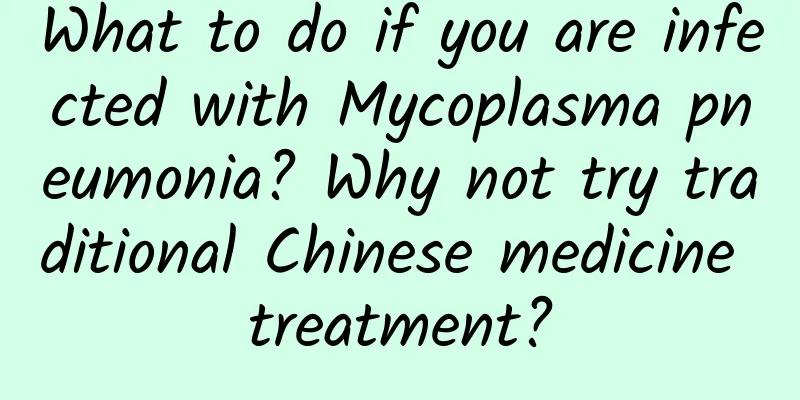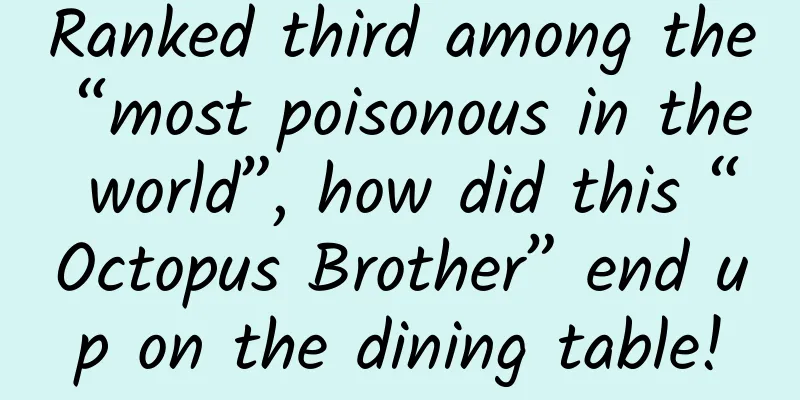What to do if you are infected with Mycoplasma pneumonia? Why not try traditional Chinese medicine treatment?

|
Recurrent fever, constant dry cough at night... Recently, many patients infected with Mycoplasma pneumonia have appeared in hospitals across the country, especially children. For a time, "Mycoplasma pneumonia" became a hot search. "This year is a big year for the spread of mycoplasma. Since late September, in clinical work, it has been obvious that more and more children are suffering from mycoplasma pneumonia, and there has been a small peak in visits recently. The characteristics of mycoplasma infection this year are mainly school-age children, with persistent high fever and cough as the main manifestations, and a high incidence of pneumonia." Kong Fei, deputy director of the Department of Pediatrics at Jiangsu Provincial Hospital of Traditional Chinese Medicine, said that many parents are anxious because their children have mycoplasma pneumonia infection. So how is the efficacy of traditional Chinese medicine treatment? Let's listen to what traditional Chinese medicine experts say. Does Mycoplasma pneumoniae infection necessarily require treatment? Kong Fei introduced that the recent high incidence of mycoplasma pneumonia is caused by Mycoplasma pneumoniae, with symptoms of fever, paroxysmal irritating cough, a small amount of mucous or mucopurulent sputum, headache, fatigue, myalgia, nasopharyngeal lesions, and even chest pain, purulent sputum and bloody sputum. It is more common in children or adolescents. The incubation period is 2 to 3 weeks, and the onset is slow, appearing in the form of tracheobronchitis, pneumonia, etc., with pneumonia being the most serious. "Many parents worry that their children have pneumonia when they see a positive result for Mycoplasma pneumoniae, which is a big misunderstanding." Kong Fei said that a positive result for Mycoplasma antibodies only indicates that the child may be infected with Mycoplasma, but whether it is a cold, tracheitis or pneumonia needs to be diagnosed based on the child's symptoms, signs and auxiliary examinations. Under the current circumstances, if there is a history of contact with Mycoplasma pneumoniae epidemics and a fever for more than 3 days, it is recommended to go to the hospital for treatment. Experts say that to prevent Mycoplasma pneumoniae infection, you can start from the following points: wash your hands frequently, wash your hands and face carefully after going to public places and pay attention to hand hygiene; open windows for ventilation more often to keep the indoor air clean; avoid going to crowded and poorly ventilated public places; cover your mouth and nose with your sleeves or elbows when sneezing, instead of directly covering it with your hands; eat a light and balanced diet on weekdays, drink more warm water, and do not eat fried, greasy, frozen and other foods. Traditional Chinese medicine has a good prescription "We have found in clinical practice that TCM intervention in the treatment of mycoplasma pneumonia can not only effectively control symptoms such as fever, cough, and mental state, but also shorten the course of the disease." Kong Fei introduced that mycoplasma pneumonia is considered by TCM to belong to the category of "cough" and "pneumonia wheezing cough". According to different clinical manifestations and courses of disease, the treatment principles of "dispersing", "clearing" and "nourishing" are adopted. Clinically, it is generally divided into different syndromes such as wind-cold blocking the lungs, wind-heat blocking the lungs, phlegm-heat blocking the lungs, yin deficiency and lung heat, and lung and spleen deficiency. In the early stage of the disease, the child showed symptoms such as fever, cough, aversion to cold, thin white tongue coating, and floating pulse. According to the severity of aversion to cold, thirst, tongue quality, tongue coating, and pulse, it was divided into wind-cold blocking the lungs or wind-heat blocking the lungs. For wind-cold blocking the lungs, Huagai San with additions and subtractions is generally used, including ephedra, apricot kernel, perilla, tangerine peel, white qian, and aurantium; for wind-heat blocking the lungs, Maxing Shigan Tang with additions and subtractions is generally used, and the Provincial Hospital of Traditional Chinese Medicine's Feining Mixture can also be used. The overall focus is on dispersing evil qi. In the middle stage of the disease, the child will have persistent high fever, severe cough, shortness of breath, sputum, red tongue, yellow fur, and rapid pulse. This is the peak period of the disease. The treatment principle is to clear away heat and resolve phlegm, relieve cough and relieve asthma, and mainly clear lung heat. Wuhu Decoction and Tingli Dazao Xiefei Decoction are often used. Qingfei Oral Liquid from the Provincial Hospital of Traditional Chinese Medicine can be used. In the late stage of the disease, the child's fever subsides and cough is alleviated, or the child has low fever, fatigue, dry mouth, red tongue, less coating, and a thin pulse. At this time, the main treatment is to nourish the lungs, nourish yin and clear the lungs, or nourish the lungs and spleen, and use more Adenophora Ophiopogonis Decoction or Ginseng Schisandra Decoction with modifications. You can also use the lung moistening mixture of the Provincial Hospital of Traditional Chinese Medicine. What should I do if I have a severe cough? Clinically, many children with mycoplasma pneumonia will have severe coughs after their body temperature stabilizes, and their parents will continue to give them infusions in the outpatient clinic. In fact, an obvious cough does not mean that the condition has worsened. It is necessary to combine the child's overall condition, physical signs, and imaging to judge whether the child is getting better or worse. For children with severe coughs, the rational use of Chinese medicine based on TCM syndrome differentiation has good results. The Provincial Hospital of Traditional Chinese Medicine's Feining Mixture, Qingfei Oral Liquid, Xuanfei Zhike Mixture, etc. can be used individually according to the child's coughing condition. In addition, TCM experts recommend some food therapy prescriptions that are both medicinal and edible, which can effectively relieve symptoms such as coughs: Almond stewed with pear. 15g sweet almonds, peeled and crushed; 1 pear, peeled and sliced, add 20g crystal sugar, appropriate amount of water, stew for 1 hour. Take once in the morning and evening every day, 3 to 5 times in a row. Stewed pear with Fritillaria cirrhosa. Cut a pear horizontally, remove the shell and add 6 grams of Fritillaria cirrhosa powder. Put the two halves together, fix with toothpicks, add 20 grams of rock sugar and an appropriate amount of water, and stew for 30 minutes. Eat the pear and drink the soup once a day for 3 to 5 days. Correspondent/Sun Qian, Reporter/Ji Kan |
>>: What? It can prevent myopia. Go out for a walk!
Recommend
Those popular internet buzzwords were actually written as Spring Festival couplets, hahahahaha…
The Spring Festival is coming again, and the Spri...
Ginkgo nuts are ripe. Some say they are poisonous, while others say they are beneficial. Do you know how to eat them in the safest way?
Ginkgo trees are tall and straight, with fan-shap...
Analysis of Himalaya's competitive products
Preface : From Himalaya , I have briefly analyzed...
Luliang Mini Program Franchise Company, how much does it cost to join a fresh fruit and vegetable delivery mini program?
Mini programs are now very popular in various ind...
In Poyang Lake, rotifers create 133 trillion plastic particles every day
The total number of nanoplastic particles produce...
Behind the touching story, how does Jiang Xiaobai think about its brand strategy?
Jiang Xiaobai CMO Ye Ming told the Camp Creation ...
Tik Tok Promotion: How to make money through Tik Tok? Please keep this guide!
1. How to make money from short videos on Douyin ...
Information flow advertising algorithm mechanism: one formula applies to the entire industry!
Recently, classmate Xiao A reported to Qingguajun...
3+7 routines to teach you how to play poster fission
There is a very important way to attract fans to ...
Three major issues to pay attention to and principles to follow when placing advertisements
The competition in information flow advertising i...
How to promote and attract new users during the cold start phase of APP?
As the threshold for APP development is lowered, ...
Wuhan SEO Training: How to optimize website clicks and retention rate?
Whether readers visit computer websites, mobile w...
How much does it cost to be an agent of Guang'an Timber Mini Program? What is the price quoted by Guangan Timber Mini Program Agent?
What is the price of Guangan Timber Mini Program ...
Plastic bottles, glass bottles, paper packaging, do you know the secrets of beverage packaging bottles?
When the weather gets hot, the first thing people...
Wang Peng of Yihui Zhongmeng: Offline big data - the next outlet for intelligent technological innovation
[51CTO.com original article] The WOT 2016 Big Dat...









